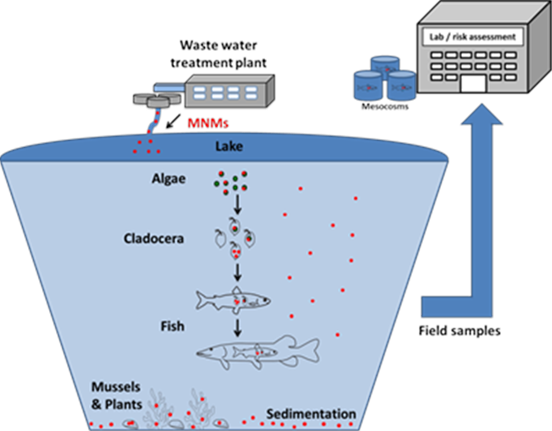
Relevance of the Problem
Manufactured nanomaterials (MNMs) altered by the treatments in waste water treatment plants (WWTPs) may pose a risk for the environment. Via transfer of post-WWTP MNMs in food webs and bioaccumulation this may lead ultimately to risks also for human health. The assessment of chronic toxicological endpoints and the bioaccumulation potential is hence an important part of the substance evaluation and requires test systems suitable for MNMs. Furthermore, such studies need to be carried out not only on pristine MNMs, but also on NPs processed by WWTP to allow for a realistic hazard and risk assessment. To evaluate existing impact of MNMs in aquatic ecosystems there is a need for fast detection methods. These methods developed and refined in FENOMENO will help to generate a more efficient system to monitor the impairment of ecological functionality by post- WWTP MNMs. If available, this will allow the validation of the risk assessment that is indispensable to understand the impact of end-of-life MNMs on the environment and to ensure a safe use of MNMs.

Project Focus and Targets
|
|
|
Analysis of Ag and TiO2 MNMs in model and real WWTP effluents. |
|
Development of analytical procedures for the determination and characterization of MNMs in very low environmental concentrations (fundamental for monitoring approaches, e.g. within Water Framework Directive 2000/60/EC); adaptation of the model WWTP according to OECD 303 for MNM testing, identification & validation of biomarkers to show clear response following MNMs exposure. |
|
Chronic exposure of algae, Daphnia, and fish to investigate behavioural changes and trans-generational effects, impact on growth, reproduction and survival (algae, Daphnia, fish) and impact on selected biomarkers induced by wastewater-borne MNMs (laboratory approach). |
|
Laboratory studies on transfer of MNMs in a 3 step food chain (algae, Daphnia, fish). Investigation of tissue distribution of bioaccumulated MNMs in test organisms. |
|
Monitoring of field samples (water, algae, Daphnia, fish samples etc.) collected from Lake Mondsee, Austria. |
|
Assessment of environmental effects caused by wastewater-borne MNMs in Lake Mondsee based on calibrated biomarkers and bioaccumulation in biotic components. |
|
Determination of effects of long-term exposure to MNMs in three taxonomic/functional groups as well as in long-term exposed natural aquatic populations. |
|
Compute risks quotients for single exposure to MNMs and to a mixture of MNMs (TiO2 and Ag), and apply the framework to make a retrospective risk assessment in a real MNM contamination scenario at Lake Mondsee. |
|
Determination of toxic effects of pristine and WWTP transformed MNM to three taxonomic/functional levels (considered in REACH for traditional chemicals). Computation of retrospective risk in a real MNM contaminated case study, based on lab and field data. |
